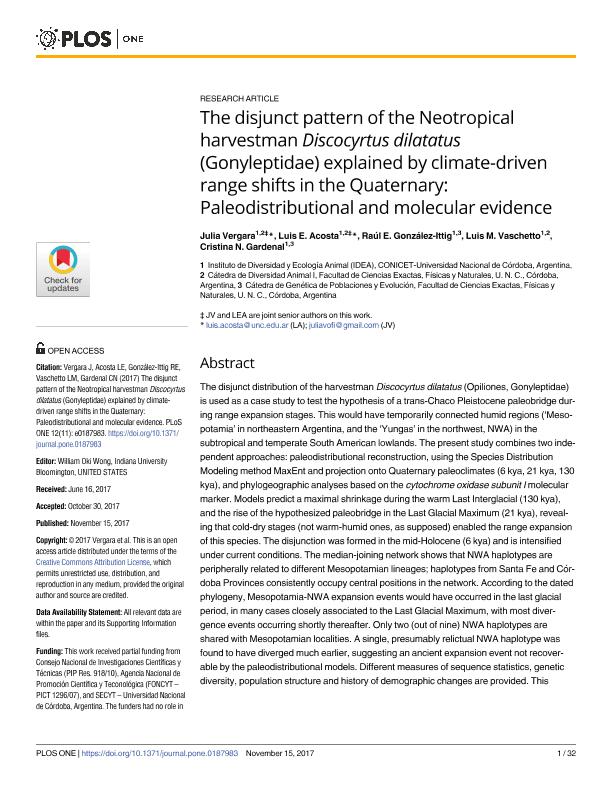Mostrar el registro sencillo del ítem
dc.contributor.author
Vergara Oficialdegui, Julia

dc.contributor.author
Acosta, Luis Eduardo

dc.contributor.author
González Ittig, Raúl Enrique

dc.contributor.author
Vaschetto, Luis Maria Benjamin

dc.contributor.author
Gardenal, Cristina Noemi

dc.date.available
2018-08-24T17:06:05Z
dc.date.issued
2017-11
dc.identifier.citation
Vergara Oficialdegui, Julia; Acosta, Luis Eduardo; González Ittig, Raúl Enrique; Vaschetto, Luis Maria Benjamin; Gardenal, Cristina Noemi; The disjunct pattern of the Neotropical harvestman Discocyrtus dilatatus (Gonyleptidae) explained by climate-driven range shifts in the Quaternary: Paleodistributional and molecular evidence; Public Library of Science; Plos One; 12; 11; 11-2017
dc.identifier.uri
http://hdl.handle.net/11336/57002
dc.description.abstract
The disjunct distribution of the harvestman Discocyrtus dilatatus (Opiliones, Gonyleptidae) is used as a case study to test the hypothesis of a trans-Chaco Pleistocene paleobridge during range expansion stages. This would have temporarily connected humid regions (‘Mesopotamia’ in northeastern Argentina, and the ‘Yungas’ in the northwest, NWA) in the subtropical and temperate South American lowlands. The present study combines two independent approaches: paleodistributional reconstruction, using the Species Distribution Modeling method MaxEnt and projection onto Quaternary paleoclimates (6 kya, 21 kya, 130 kya), and phylogeographic analyses based on the cytochrome oxidase subunit I molecular marker. Models predict a maximal shrinkage during the warm Last Interglacial (130 kya), and the rise of the hypothesized paleobridge in the Last Glacial Maximum (21 kya), revealing that cold-dry stages (not warm-humid ones, as supposed) enabled the range expansion of this species. The disjunction was formed in the mid-Holocene (6 kya) and is intensified under current conditions. The median-joining network shows that NWA haplotypes are peripherally related to different Mesopotamian lineages; haplotypes from Santa Fe and Córdoba Provinces consistently occupy central positions in the network. According to the dated phylogeny, Mesopotamia-NWA expansion events would have occurred in the last glacial period, in many cases closely associated to the Last Glacial Maximum, with most divergence events occurring shortly thereafter. Only two (out of nine) NWA haplotypes are shared with Mesopotamian localities. A single, presumably relictual NWA haplotype was found to have diverged much earlier, suggesting an ancient expansion event not recoverable by the paleodistributional models. Different measures of sequence statistics, genetic diversity, population structure and history of demographic changes are provided. This research offers the first available evidence for the historical origin of NWA disjunct populations of a Mesopotamian harvestman.
dc.format
application/pdf
dc.language.iso
eng
dc.publisher
Public Library of Science

dc.rights
info:eu-repo/semantics/openAccess
dc.rights.uri
https://creativecommons.org/licenses/by-nc-sa/2.5/ar/
dc.subject
Discocyrtus Dilatatus
dc.subject
Species Distribution Modeling
dc.subject
Phylogeographic Analyses
dc.subject
Opiliones
dc.subject.classification
Otras Ciencias Biológicas

dc.subject.classification
Ciencias Biológicas

dc.subject.classification
CIENCIAS NATURALES Y EXACTAS

dc.title
The disjunct pattern of the Neotropical harvestman Discocyrtus dilatatus (Gonyleptidae) explained by climate-driven range shifts in the Quaternary: Paleodistributional and molecular evidence
dc.type
info:eu-repo/semantics/article
dc.type
info:ar-repo/semantics/artículo
dc.type
info:eu-repo/semantics/publishedVersion
dc.date.updated
2018-08-17T14:32:30Z
dc.identifier.eissn
1932-6203
dc.journal.volume
12
dc.journal.number
11
dc.journal.pais
Estados Unidos

dc.journal.ciudad
San Francisco
dc.description.fil
Fil: Vergara Oficialdegui, Julia. Consejo Nacional de Investigaciones Científicas y Técnicas. Centro Científico Tecnológico Conicet - Córdoba. Instituto de Diversidad y Ecología Animal. Universidad Nacional de Córdoba. Facultad de Ciencias Exactas Físicas y Naturales. Instituto de Diversidad y Ecología Animal; Argentina
dc.description.fil
Fil: Acosta, Luis Eduardo. Consejo Nacional de Investigaciones Científicas y Técnicas. Centro Científico Tecnológico Conicet - Córdoba. Instituto de Diversidad y Ecología Animal. Universidad Nacional de Córdoba. Facultad de Ciencias Exactas Físicas y Naturales. Instituto de Diversidad y Ecología Animal; Argentina
dc.description.fil
Fil: González Ittig, Raúl Enrique. Consejo Nacional de Investigaciones Científicas y Técnicas. Centro Científico Tecnológico Conicet - Córdoba. Instituto de Diversidad y Ecología Animal. Universidad Nacional de Córdoba. Facultad de Ciencias Exactas Físicas y Naturales. Instituto de Diversidad y Ecología Animal; Argentina
dc.description.fil
Fil: Vaschetto, Luis Maria Benjamin. Consejo Nacional de Investigaciones Científicas y Técnicas. Centro Científico Tecnológico Conicet - Córdoba. Instituto de Diversidad y Ecología Animal. Universidad Nacional de Córdoba. Facultad de Ciencias Exactas Físicas y Naturales. Instituto de Diversidad y Ecología Animal; Argentina
dc.description.fil
Fil: Gardenal, Cristina Noemi. Consejo Nacional de Investigaciones Científicas y Técnicas. Centro Científico Tecnológico Conicet - Córdoba. Instituto de Diversidad y Ecología Animal. Universidad Nacional de Córdoba. Facultad de Ciencias Exactas Físicas y Naturales. Instituto de Diversidad y Ecología Animal; Argentina
dc.journal.title
Plos One

dc.relation.alternativeid
info:eu-repo/semantics/altIdentifier/url/http://dx.plos.org/10.1371/journal.pone.0187983
dc.relation.alternativeid
info:eu-repo/semantics/altIdentifier/doi/https://doi.org/10.1371/journal.pone.0187983
Archivos asociados
